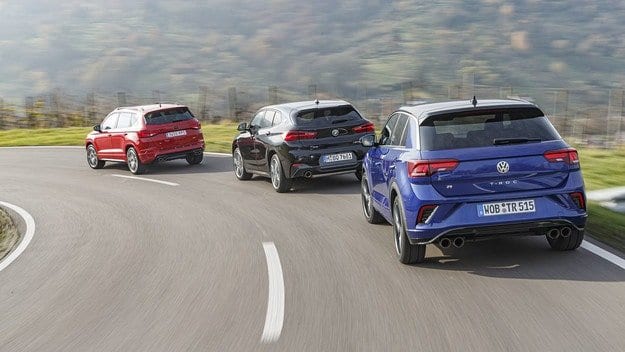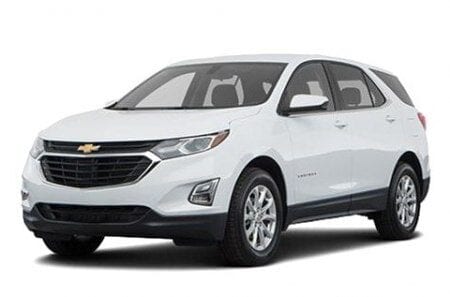
Test drive BMW X2 M35i, Cupra Ateca, VW T-Roc R: Merry company

Comparison of three powerful compact SUV models with dynamic character
Compact SUV models have a reputation for being intelligent, practical and reliable vehicles. However, in their most powerful performances, the BMW X2, Cupra Ateca and VW T-Roc all have 300 or more horsepower, which is a serious sporting statement. But is the power alone enough to challenge the superiority of classic compact sports models?
Will these three SUV models one day achieve the same cult status as their smaller compact counterparts, the Unit, the Leon Cupra and even the Golf GTI? We don't know. However, the fact is that buyers of SUVs have not lost their desire to drive dynamically. The idea of combining two worlds is so close to my mind. Irreconcilable contradictions? Let's see how the BMW X2 M35i and Cupra Ateca will compete against the latest phenomenon of this type, the VW T-Roc R.
For more drama, the newcomer to the group will start last, and instead we will start with Cupra Ateca. Basically, it's a classic Seat with respectable utility and sporty character, but the problem is that it's no longer allowed to carry the Seat name, even though it is, including in appearance. It seems that too few people are willing to invest big money - in Germany at least 43 euros - in a 420 hp SUV model. with Seat logo front and back. Thus, in 300, the idea was born on the example of PSA's DS to create a new, more prestigious brand. However, even the name Cupra (for "Cup Racer") is identified as motorsport-related.
More space, less Cup Racer
There isn't really a racing version of the Ateca, but the SUV model we tested can't be blamed for that. Especially considering the many extras included in the base price: plush 19-inch wheels, rearview camera and keyless entry, the list is long. Orange Cupra emblems and carbon-look textile coverings noticeably decorate the interior of the Spaniard. The €1875 sport seats earn points for good lateral support, but they're set quite high and, despite being electrically adjustable, don't fit perfectly to every figure. The impression of quality is good - also due to the generously invested Alcantara. Only insufficient soundproofing lets in aerodynamic noise on the track and chassis rattle on bad roads.
Thanks to the fourth body, the Ateca offers the most space not only for rear passengers. The trunk has a volume of 485 liters, which can be expanded to 1579 liters by remotely folding the rear seat backs. The fact that the model is older than the T-Roc is evident, firstly, from the limited amount of multimedia as well as functional controls, and secondly, in a positive way: the infotainment system impresses with classic switches and rotary knobs, as well as clear buttons on the steering wheel. Added to this is the road dynamics menu, which offers easy selection via a jog dial, but can also be refined by delving deeper into the settings without risking getting lost among them. And the standard digital instrument cluster with various sports indicators shows a really high class.
When it comes to sport and power, the Cupra is most willing to show its 300 horses on the freeway with no speed limits, but it doesn't feel out of place in many corners. There, however, when driving vigorously, the tall Ateca body begins to shake, because its chassis surprises with a significant margin of comfort. The adaptive suspension, which comes standard here and costs an additional 2326 leva on the VW model, is nicely installed in the Cupra, but not as rigid as in the T-Roc.
This is also felt in road dynamics tests, where the car is further constrained by the safer ESP system. Added to this is a steering system that operates straight from the middle steering wheel position, but is somewhat unnoticeable and makes the Ateca feel more awkward than it really is. On the other hand, a Brembo braking system, which costs up to € 2695, could have a stronger effect.
The BMW X2 can't be blamed for its lack of agility (at least on the test track), though its front-wheel-drive platform has plunged the BMW fan community into a deep religious crisis. In doing so, the X2 transfers the power of its engine to the road through its four wheels. And here we already hear another cry of orthodoxness - after all, behind the abbreviation M35i is no longer a six-cylinder in-line engine, as before, but a four-cylinder turbocharged automatic, like the brothers from the VW concern.
X2 M35i: tough but hearty
By the way, both new items are not a disadvantage - after all, a two-liter gasoline unit with a capacity of 306 hp. a real hit: 450 Nm (50 Nm more than the Ateca and T-Roc) loads the crankshaft even below 2000 rpm, i.e. much earlier. However, in terms of acceleration measurement, the BMW model lags behind a little, part of the blame for which lies with the highest curb weight of 1660 kg. In any case, the reason is not the eight-speed automatic transmission, which in the sport position selects exactly the right gear and signals the shift with a little pressure. Only the comfortable mode can be annoying with artificially long pauses in the transitions between steps.
The sound is also not entirely suitable - from the outside it is clearly audible thanks to the dampers in the muffler, inside it is completely spoiled by artificially added tin intonations. However, even more refinement is required for the chassis, which is more rigidly tuned than many M GmbH sports cars. In addition, it offers almost no customization options. Under ideal conditions on a flat, tray-like race track, the M35i probably performs well, but how many off-road vehicles did you see in those free-track days? On more imperfect road surfaces, the X2 bounces off any, even very small, bumps and at the same time interferes with responsive steering.
Despite good M-Performance stopping distances, the brakes create rather hesitant brake pedal drag, which can easily lead to understeer if the cornering speed is not chosen correctly. On the other hand, the M-problem X2 gives a lot of freedom to its rear end - when released and accelerated hard, the dual transmission model moves the rear end to the side, which is quite funny for experienced pilots, but takes time to get used to the car. .
However, you quickly get used to the situation with BMW, which costs at least 107 leva. Although the lava red leather upholstery and the price of 750 2830 leva give rise to opposite opinions, the quality of the model looks one class higher than that of the competitors. The optional sports seats are narrow, typical of BMWs, adjustable in different ways, but positioned too high. High traffic lights are almost invisible through the low windshield. The headroom in the back, however, suffers very little from the low roof. Behind the electric hood is a 470-liter boot with a deep storage compartment at the bottom, which can be expanded up to 1355 liters by folding the three-piece backrest.
As usual, BMW scores points for easy control of functions, for which the infotainment system gives the user a choice between a touchscreen, a rotary and button controller and voice commands. However, the system does not correspond to the latest technology because it does not speak colloquially. The driver assistants also need updating. For example, adaptive cruise control is limited to 140 km / h and only roughly controls the distance to other road users.
T-Roc ‘n’ Roll
For its part, VW's automatic cruise control helps the driver accelerate to 210 km / h and doesn't overtake slower cars in the right-hand lane, but a regular T-Roc without sportswear can do that. The same holds true for the space offered in the only 4,23m long SUV model, which, barring a smaller trunk, is pretty decent. However, for many of the options that are standard on Cupra, you will have to pay extra here.
These include the infotainment system, which, with its many areas of activity, does not necessarily facilitate faster target acquisition. However, the quality of the materials used seems to be below average given VW's scale and base price of around 72 leva. Perhaps hard plastic in the door panels and dashboard will save not only a few cents, but also weight.
Indeed, driving a 1,5-ton car gives the impression that the saved few euros are being invested in important traffic elements. For example, with the help of a switch with a button, the R-model offers, in addition to off-road and snow modes, also driving profiles - from Eco to Comfort to Race. Almost too generous, especially since the settings can be customized, like the Ateca. Among the sports controls, we even find a stopwatch to measure lap times – in case someone comes up with the idea of setting a record for compact SUV models at the Nürburgring. He would stand a good chance with the T-Roc R, which has stiffer suspension than the Cupra due to numerous chassis modifications. However, unlike the X2, the dual-drive model retains satisfactory residual comfort.
R as Racing
The pleasantly deep seat almost suggests the Golf's familiar comfort feel - otherwise the Wolfsburg SUV model is surprisingly close to the compact class leader. Its purposeful and even in normal mode extremely responsive steering system gives feedback to the road surface without getting lost in detail like the X2. Thus, the T-Roc R turns between the pylons at the level of the current Golf GTI. The ESP system intervenes late, but is never completely indifferent. This makes driving easy and inspires confidence without getting bored.
After all, with such agile demeanor, the T-Roc R quietly pulls away from the competition, even on a small road. Its turbocharged four-cylinder engine pulls like a sting, thanks to its linear characteristics, the accelerator pedal is controlled more intelligently, and compared to its Cupra counterpart, it is less involved in the DSG transmission controversy. The dual-clutch transmission allows manual intervention via two large, removable discs on the steering wheel, but does not respond to driver commands when pressure rises and at wide open throttle. Compensation for this is offered by the Akrapovic exhaust, which costs a whopping 3800 euros, with a pubertal scream that, thanks to the valve control, can be adjusted so as not to annoy the neighbors.
So the T-Roc R first overtakes the Ateca and then the X2, which finally stumbles due to its high price. More importantly, the T-Roc is the only one that really gives off a GTI feel.
CONCLUSION
1. VW
The T-Roc R accelerates horribly, brakes superbly, turns fantastic, and avoids weak points aside from a poor material impression and small trunk.
2.CUPRA
The Ateca is very spacious, surprisingly comfortable, well furnished and relatively inexpensive. Only as a sports car the Spaniard is not at the level of others.
3. BMW
The drivetrain is delightful, but the chassis is too rigid for everyday use. For the combination of high-quality materials, BMW demands a premium on the already high price tag of the X2.
text: Clemens Hirschfeld
a photo: Ahim Hartman
